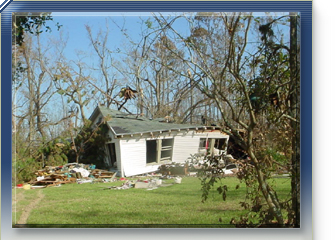Katrina Recap
Executive Summary of the Naval Postgraduate School’s
Hurricane Katrina Response
A few days after Hurricane Katrina devastated the US Gulf Coast, the Naval Postgraduate School in Monterey California (NPS) received a request from Fleet Numerical Oceanography and Meteorologic Command (FNMOC) and Naval Oceanography Center (NAVO) to leverage prior NPS experience setting up Hastily Formed Networks (HFN’s) during the SE Asian tsunami by deploying NPS faculty and students and NPS’s Nemesis Mobile Research Facility (a 33 foot RV converted into a wireless networks research platform) down to Stennis Space Station Mississippi to bring NAVO back online with SATCOM based internet access. NPS received DoD guidance/orders as ADCON to NPS, TACON to Joint Forces Maritime Component Command (JFMCC) and OPCON to Joint Task Force Katrina (JTF Katrina) to immediately deploy to Mississippi for that mission. Upon deploying to NAVO on 3 September, NPS learned that NAVO was well on their way to reconstituting their broadband connectivity and was redeployed by JFMCC to the Hancock County Mississippi Emergency Operations Center (EOC) to assist the EOC with providing SATCOM enabled broadband wireless Internet connectivity to the county hospital, local gov't offices, police/fire stations, and temporary emergency services locations in the towns of Bay St. Louis and Waveland Mississippi, which were ground zero for Hurricane Katrina.
NPS teamed with OSD-NII and several vendors (Cisco, Microsoft, Redline, and Mercury Data Systems) to create the first and only publicly accessible broadband wireless hotspot clouds in an area that suffered virtually 100 percent disruption of all communications capabilities caused by up to 20 feet of storm surge. The NPS led team of industry and DoD entities successfully integrated key wireless technologies (802.11, 802.16, SATCOM, Voice Over Internet Protocol) in a disaster zone bringing the first Internet connectivity and dial-tone telephony to the entire region. First responders, many local hurricane victims, relief agencies, city/county government, and hundreds of volunteers were able to communicate with the outside world for the first time as a result of the Hastily Formed Network.
Within 5 hours of NPS’s equipment reaching the first site that the EOC requested help with (Hancock County Memorial Hospital) the NPS/Vendor team had satellite broadband Internet, email, VoIP, and web access available for myriad agencies that had set up for emergency operations in the hospital parking lot (including FEMA, Federal Protective Service, Florida Disaster Medical Assistance Teams (DMAT), National Guard Emergency Medical Unit, National Guard Security Unit, Disaster Mortuary Team (DMORT), regional ambulance service providers, and the hospital staff. The team then began systematically connecting other local sites to the networks (K-Mart, WalMart, Freds parking lots turned into emergency operations facilities and public shelters). The networks were maintained until the end of September when FEMA contracted for an outside vendor to replace/maintain the NPS led Hastily Formed Network.
NPS’s ongoing research in Hastily Formed Networks for Humanitarian Assistance/Disaster Relief, particularly their work for the SE Asian tsunami and Hurricane Katrina is being leveraged by OSD-NII as a model for using inexpensive commercial-off-the-shelf (COTS) integrated wireless technologies to rapidly provide basic urgently needed communications to disaster zones—both domestic and international. The lessons learned from these activities will help drive new policy, generate HFN and HA/DR Concepts of Operations, will facilitate possible updates to the National Disaster Plan, and will help DoD solve some of the non-technical social and civil-military boundary issues that have become more acute in the spate of recent large scale disasters.
